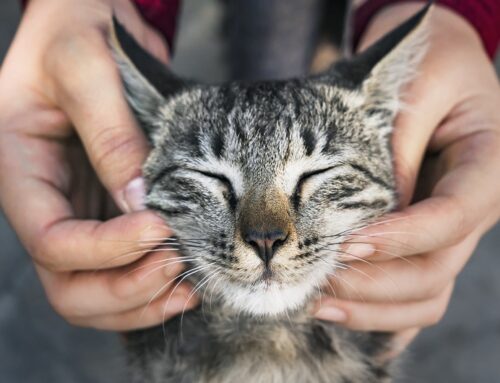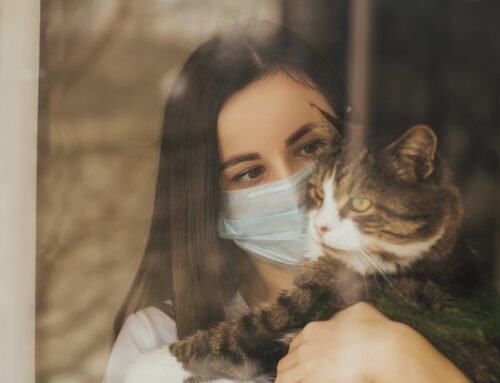The summer travel season is here once again, and many of us will be traveling with our pets. While lots of people will be traveling with their dogs, there are an increasing number of people traveling with their cats. It is not as impossible as it seems, and many cats like to travel and see new things! There are even people who camp and hike with their cats. While a lot of cats won’t take instantly to travel, I’ve covered getting cats used to the car in a previous newsletter. This newsletter will discuss some things to know about traveling, including out of state or out of the country.
1. Car/truck/motorhome: Just as it is for us, it is always best to travel with your cat secured. A carrier that is secured in place is best. In fact, there are carriers now being made with seatbelt holders. Another alternative is a harness made for a seatbelt strap. Securing your cat prevents them from wandering around the vehicle and into a potentially unsafe place, such as under the foot pedals. This also prevents them from jumping out of the car and running off whenever anyone gets in or out of the car. Securing your cat also prevents (or helps minimize) the chance of your cat getting hurt in the event of a sudden stop or accident.
If you stop at a rest area and want to let your cat out to stretch its legs, remember to always have them on a leash and harness, even if they will not be exiting the vehicle. Cats are very good at sneaking or bolting out doors when you least expect it, or even when you do expect it. To prevent spillage, food, water, and a litter box should only be offered when the vehicle is not moving. As always, NEVER leave a pet in a vehicle with closed windows when the outside temperature is over 70 degrees. Cats and dogs have a normal body temperature that is higher than ours, and they will quickly overheat. Park in a shady area and leave the windows open, as “cracked” windows will not allow enough ventilation to keep the car from becoming too hot. I have also seen people leave the car running with the air-conditioner on. Another option, if you are traveling and will be out for the day (versus staying in a hotel), is to board your cat for the day.
2. Airplane: Plane travel is a bit different than car travel and can potentially cause more anxiety for your cat. There will be a lot more unfamiliar noises and sensations, both at the airport and during travel. Many cats will require a light sedative or anti-anxiety supplement to prevent nervous yowling and facilitate getting through security, as they will typically need to be removed from the carrier at the security checkpoint and then placed back in on the other side.
Most airlines will require a health certificate issued within 10 days of travel. Some only require a current rabies certificate. Always check with the airline before arriving at the airport to ensure that you have the proper documents ready. Also, check with the airline on the recommended kennel size for your trip. Not all “airline approved” travel carriers will fit under the seat of all airplanes. As cats will not have the option for a bathroom break, place a pee-pad on the bottom of the carrier. This will make “accidents” easier to clean up. Keep a couple spare pee-pads in your carry-on also. If your cat is sedated, do not offer food or water until you have reached your final destination and after the sedation has worn off, as some sedatives can potentially cause vomiting.
3. Out of state travel: There is no specific documentation needed for cats or dogs for travel out of Montana, or most other states. However, states almost always require a current rabies vaccine for the pet to be “legal”. Your cat should also be current on a feline distemper vaccine, and if it will be in contact with other cats or going outside, a feline leukemia vaccine. Other parts of the country may also have different strains of some viruses that are endemic to that area, so always prevent contact with unknown cats. All cats should also receive a flea, tick, and heartworm preventative before travel. We typically do not have heartworm in Montana, but it is a risk in many other parts of the country. Heartworm is transmitted by mosquitos and is frequently fatal in infected cats, as we have no treatment for the disease in cats like we do for dogs.
4. Travel out of the country: If you are traveling out the country with your cat, there will always be a bit more paperwork involved. Most countries will at least require an international health certificate 10 – 30 days before travel, depending on the country requirements. Some countries will require their own health certificate to be filled out and signed by an accredited veterinarian. Accredited veterinarians have additional training and a special designation from the USDA; not all veterinarians are accredited. (Personally, I have a Category II USDA accreditation.) Always check on the country requirements before travel. The USDA offers a website to help check country requirements here: www.aphis.usda.gov/aphis/pet-travel. It is best to check the country requirements as soon as you know you will be traveling with your pet. I have seen too many pet owners come in for a health certificate for travel, only to find out that they need additional paperwork and that there is not enough time to get it together. Any place that is “Rabies free” will be very difficult to travel with a pet to, including Hawaii. “Rabies free” areas take at least 6 – 9 months to complete requirements for travel. Many owners find it easier and less expensive to board their cats, even if they are going for an extended period of time (over a month).
If you are traveling or would like to travel with your cat at any time, call or e-mail the clinic with any questions or concerns. Don’t wait until the last minute! As we head into warmer weather, we wish everyone and everykitty a safe and fun summer season! =^_^=








